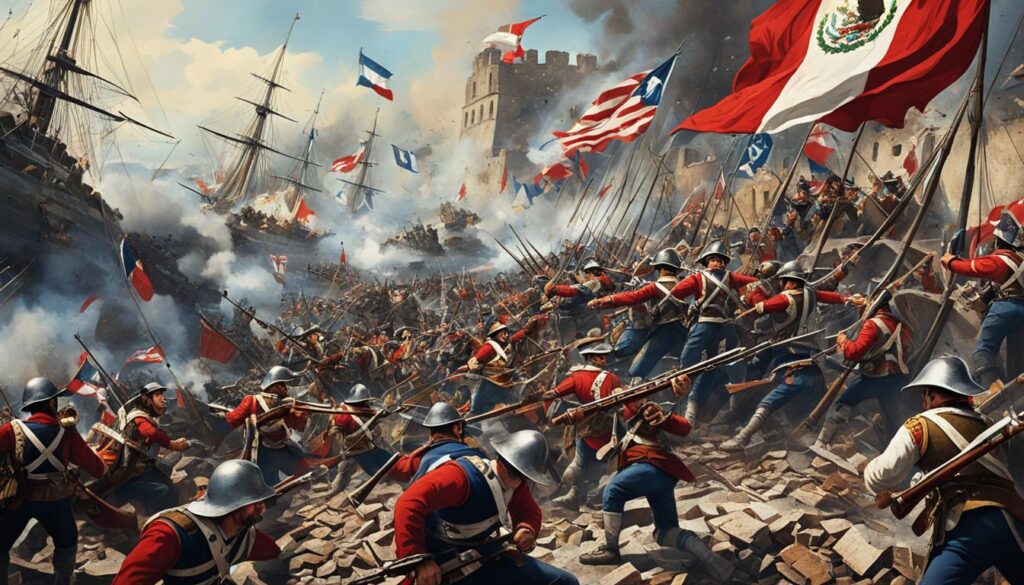In the annals of history, there have been many unusual and surprising causes for wars between nations. One of the most peculiar conflicts was the Pastry War, also known as the Franco-Mexican Pastry War, which took place between France and Mexico from 1838 to 1839. This brief but notable dispute arose from a seemingly trivial matter: a pastry shop dispute in Mexico involving a French baker.
The origins of the Pastry War can be traced back to 1832, when a French pastry cook named Monsieur Remontel, who lived in Tacubaya, Mexico, claimed that Mexican army officers had damaged his restaurant. Remontel demanded a staggering 60,000 pesos in reparations from the Mexican government. France decided to back up its citizen’s demand by sending a naval fleet to blockade Mexican ports on the Gulf of Mexico and bombard the fortress of San Juan de Ulúa in Veracruz, escalating the pastry shop dispute into a full-blown international conflict.
Key Takeaways
- The Pastry War was a brief conflict between France and Mexico from 1838 to 1839.
- The war originated from a French pastry cook’s demand for reparations for alleged damage to his shop by Mexican soldiers.
- France sent a naval fleet to blockade Mexican ports and bombard a fortress, turning the dispute into an international conflict.
- The Pastry War is also known as the First French Intervention in Mexico or the First Franco-Mexican War.
- Despite its unusual name, the Pastry War had significant consequences for Mexico and its relations with European powers.
The Pastry War: A Brief Conflict Between France and Mexico
The Pastry War, also known as the First French Intervention in Mexico, was a brief military conflict between France and Mexico that lasted from 1838 to 1839. The conflict began when French forces, in response to Mexico’s refusal to pay the 600,000 pesos in damages, initiated a naval blockade of Mexican ports and bombarded the San Juan de Ulúa fortress in Veracruz.

By December 1838, French forces had captured the city of Veracruz, prompting Mexico to declare war on France. Antonio López de Santa Anna, the famed Mexican general and politician, came out of retirement to lead the Mexican forces against the French at the Battle of Veracruz.
During the battle, Santa Anna was wounded in the leg by French grapeshot. The injured leg was subsequently amputated and buried with full military honors. Despite Santa Anna’s leadership, the French forces maintained control of Veracruz until March 9, 1839, when they withdrew following the signing of a peace treaty in which Mexico agreed to pay the demanded damages to French citizens.
Causes of the Franco-Mexican Pastry War
The Franco-Mexican Pastry War, also known as the First French Intervention in Mexico, arose from a combination of factors, including foreign property damage, Mexican civil unrest, unequal French trade agreements, and outstanding debt disputes. In the early years of Mexico’s independence, the country experienced widespread civil disorder, which often led to the destruction or looting of private property, including that of French nationals residing in Mexico.
French citizens had repeatedly pressed the Mexican government to compensate for the losses they claimed to have suffered due to the Mexican civil unrest. Notable incidents included the looting of French shops in 1828 and the execution of a French citizen accused of piracy in 1837. These events, coupled with the lack of satisfactory response from the Mexican government, heightened tensions between the two nations.
Despite being Mexico’s third-largest trade partner, France found itself at a disadvantage compared to the United States and Britain. French trade agreements with Mexico were less favorable, resulting in higher taxes on French goods. This discrepancy in trade relations further strained the already tense relationship between France and Mexico.
Moreover, Mexico’s existing debt disputes with European nations, including France, played a significant role in the outbreak of the Pastry War. Mexico’s inability or unwillingness to settle these debts promptly added to the growing list of grievances that France held against the nation, ultimately contributing to France’s decision to intervene militarily in what became known as the Pastry War.
The Impact and Consequences of the Pastry War
The Pastry War, despite being a relatively brief conflict, had far-reaching consequences for Mexico. One of the most significant outcomes was the return of Santa Anna to power. The war provided him with an opportunity to re-establish his political influence and pave the way for his future role in shaping Mexico’s destiny.
Economically, the Pastry War dealt a severe blow to Mexico. The country was forced to pay a substantial indemnity of 600,000 pesos to France, a sum that further strained its already weakened economy. Additionally, Mexico had to bear the costs of rebuilding the damaged port city of Veracruz and suffered from months of lost customs revenue, as Veracruz was its most important port. These financial setbacks left Mexico in a vulnerable position, just a few years before it would face another major conflict with the United States in the Mexican-American War.
The Pastry War also set a precedent for French intervention in Mexican affairs. The conflict demonstrated France’s willingness to use military force to protect its interests and influence in the region. This pattern of intervention would culminate in the 1860s when France, under Napoleon III, would install Maximilian of Austria as Emperor of Mexico, backed by French troops. The Pastry War, in retrospect, can be seen as a prelude to this more significant episode in the complex history of Franco-Mexican relations.

Leave a Reply